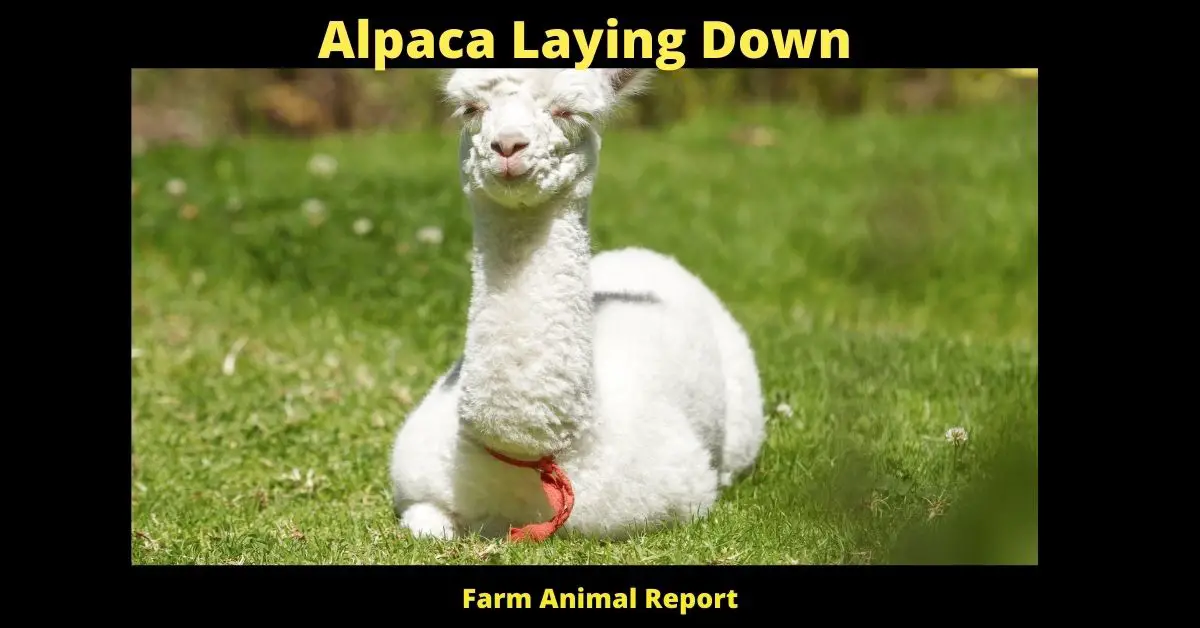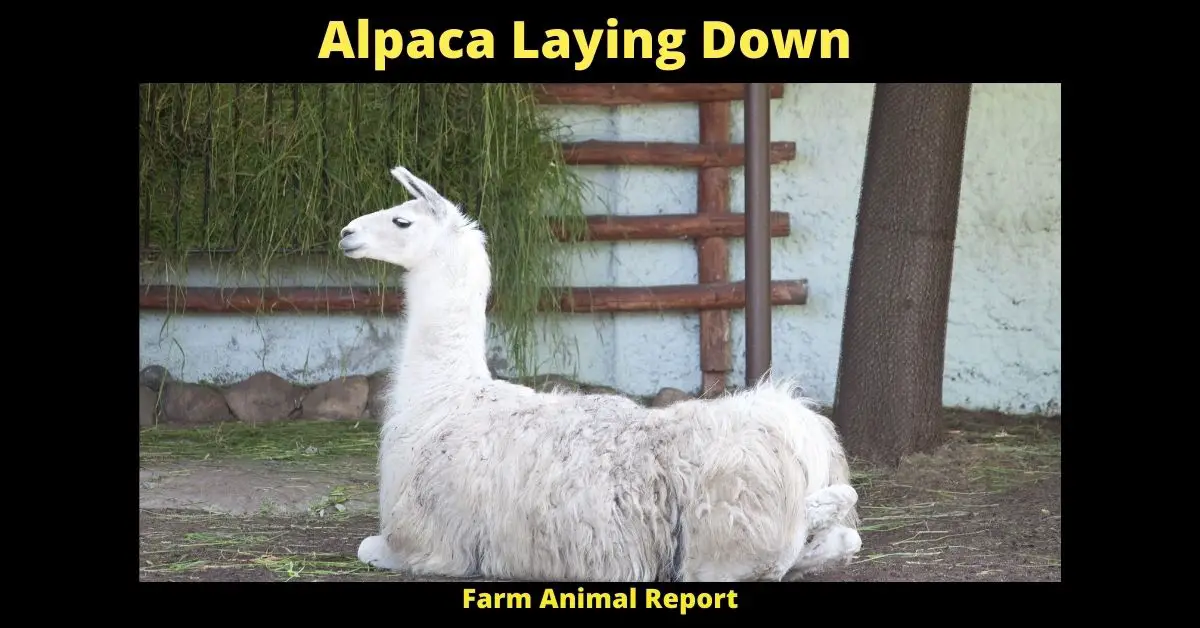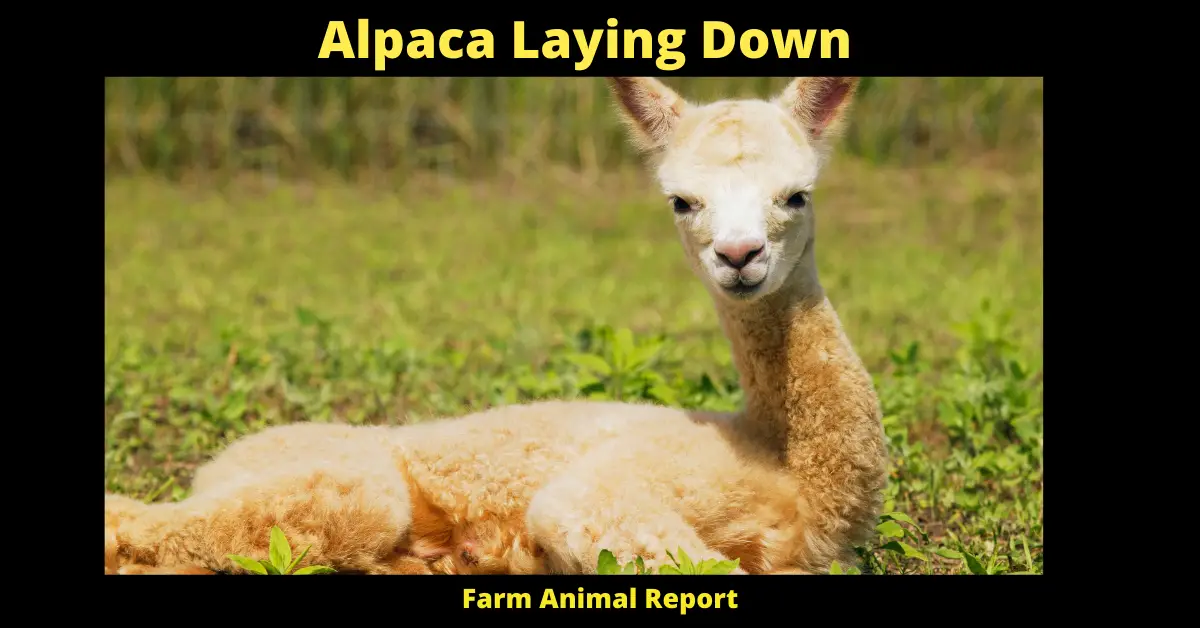As a general rule, an Alpaca laying down is normal. An Alpaca will sleep 15-18 hours a day. They spend a lot of time grazing so will stop and nap and digest their meals quite often. They are also fond of naps in the sunlight. An Alpaca might also lay down if it is sick. Any signs of sickness consult your vet.
Alpaca Laying Down
This is a picture of an alpaca laying down. Alpacas are members of the camelid family, and they are typically raised for their wool or fur. This particular alpaca has been bred to have thick, soft fur that can be used to make clothing! Alpacas are also known for their fiber production, which is called “pashmina” or “cashmere”. It can be made into sweaters and other types of clothing materials. Alpacas do not need sheering but it does help with the quality of the fleece when they are sheered.
Check Out Amazon’s Educational Resources for Raising Alpacas
What does it mean when an Alpaca Lays Down?
An alpaca laying down means that it is resting or sleeping. This may be due to a number of different things including food, water, and temperature changes. Their diets and environmental factors cause them to lay down in order to rest and get comfortable for multiple reasons.
Alpaca Laying Down – Alpacas are also known to lay down in order to regulate their body temperature when it is too hot or cold. It is important for them not only because the weather can change drastically but also because they have a heavy wool coat that makes regulating their temperatures difficult.

Alpacas are also known to lay down when they feel threatened. In the wild, this is often due to a potential predator such as a human or an animal that poses harm. Alpaca owners frequently see their animals laying down in order to avoid confrontation with other alpacas and for breeding purposes.
It can be difficult to determine whether an alpaca is laying down due to discomfort, weather changes, or possible injury. It is important for all owners to know what each of the signs is in order to ensure that their animals are healthy and happy.
When it comes time for breeding, they may lay down several times on one particular night which indicates that they are ready to mate. This is largely due to the fact that there is a strong connection between their mating behavior and laying down for other bodily needs such as food, water, or temperature regulation.
Laying down will also become more common during pregnancy in order to prepare them for the birth of their young. They may lay down several times a day or several times a week depending on the health and comfort of their baby.
Alpacas lay down at night because it is cold outside, they have to regulate their body temperature by going inside where it’s warmer so they put themselves to sleep for that purpose! When alpacas are experiencing weather changes such as rain or snow, they lay down because it is cold outside.
Signs of a Sick Alpaca
If the Alpaca is lying down it might also be sick.
If you own alpacas, it is very important to know what the signs of a sick animal are. Alpaca illnesses can be difficult to diagnose because they do not act like other farm animals when they get sick. If your alpaca has one or more of these symptoms, take them …Alpacas are very different than other farm animals.
If your alpaca has any of the following symptoms, take them to a veterinarian immediately:
- Loss of appetite
- Weight loss;
- Unusual droppings (diarrhea or constipation);
- Runny nose,
- Coughing,
- Wheezing,
- Sneezing;
- Swelling in the mouth, legs or feet.
- Fever (temperature over 103°F);
- Coughing up blood;
- Coughing up large amounts of mucous;
- Difficulty breathing with wheezing or a muffled nose.
- Diarrhea that contains blood or black looking stools;
- Severe depression and loss of appetite;
- Unconsciousness, seizures, or paralysis. If you suspect your alpaca has ingested a toxic substance such as snail bait, rat poison, or other chemicals that may be harmful to them, seek veterinary help immediately!
How do Alpacas Sleep?
Alpacas sleep standing up, and they often do so with one leg tucked underneath their body. At night, they will lay down to rest. If temperatures are cold, alpacas may sleep with their legs tucked in for warmth!
When they nap in the sun, alpacas will lie on their sides and tuck one leg underneath them. This position allows for a quick escape if needed!
An alpaca sleeping standing up is called “watchful sleep”: they look like they are watching over the herd as they rest. An easy way to tell if an animal is asleep? Their eyelashes will be closed.
If you’re curious, alpacas typically sleep between three and five hours a day. They tend to rest for longer periods following strenuous activity or bad weather!
Most alpacas sleep lying down in a cush (also spelled kush) position at night. Alpacas are also great fans of sprawling out in the sun for afternoon naps.
What does the Alp[aca Cush Position Look Like?
When the alpaca is laying down, it has its neck against the ground with its legs tucked under them. They are curled up in a ball-like shape and have one ear facing forward while the other faces back. When they want to move or get up, they start by moving their head slowly which leads to lift themselves off of the ground.
Once they are upright, both of their ears will be facing forward.
If they were standing when this started, they will move their neck to the upright position. Their tail is usually facing in between their legs and may even be tucked under them along with one or two of their feet.
Do Alpacas Lay Down a lot? / How Much do they Sleep
An alpaca sleeps for between fifteen and eighteen hours a day, often laying down to rest. One of the reasons alpacas lay down so much is their digestion system; they don’t have very good gut bacteria, which slows food digestion. However, it also means that alpacas aren’t good at breaking down grasses (one reason why they spit so often). Alpacas are grazers, and because of this, they need to eat a lot. This means that an alpaca will spend much of its time resting after eating until it digests the food.
Alpacas also have a great deal of fiber in their diets; as such, they regularly lay down to help their digestive systems process the fiber.
An alpaca will be up and about for between three to four hours a day, at which point it might lay down again before being active once more. Alpacas are typically most active during sunrise or sunset, so they may not be seen resting very often!
Alpacas can run fairly quickly, but they do not go very far as their stamina is limited. If an alpaca feels threatened or needs to escape danger, it will run away from the threat and then lay down once it has escaped.
Alpacas Love to take Naps in the Sun.
With all that lush grass, a nice field is a perfect place for their next snooze. Alpacas are used to sleeping in groups when it comes time to take a nap. They do not like being alone and will often times curl up with one another when they need some company. In fact, alpaca laying down together can be a way for them to keep warm.

How much do Alpacas Weigh?
Alpacas usually weigh between 150 to 200 pounds. They are about as heavy as a small-sized dog, but their size varies by breed and the different types of alpaca. For example, llamas tend to be much larger than alpacas.
Males are usually larger than females.
Females when pregnant can weigh up to 250 pounds.
Alpacas are also known for their fiber production, which is called “pashmina” or “cashmere”. It can be made into sweaters and other types of clothing materials. Alpacas do not need sheering but it does help with the quality of the fleece when they are sheered.
Alpacas are not like sheep or goats who need to be sheared yearly because they do not produce as much fleece. Alpaca fiber can also withstand the stress of high humidity and it does not shrink when wet, which makes it ideal for clothing materials.
Shearing alpacas is typically done once a year in the spring. Just like a dog, alpacas can get matted and tangled if they are not sheared regularly.
Final Thoughts
Alpacas are very docile animals, they are grazers and will eat and take naps at varying times. If they feel safe they will recline in the cush position for sleeping and naps. At Night one might stand guard watching the rest of the herd. While the others lay down.


